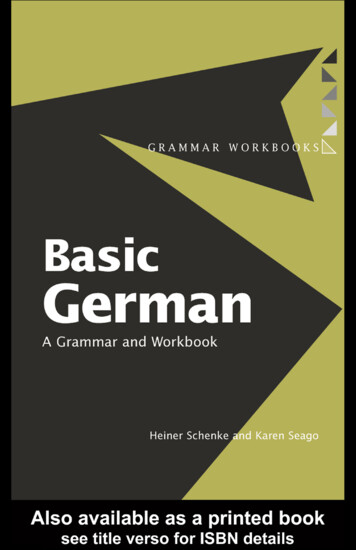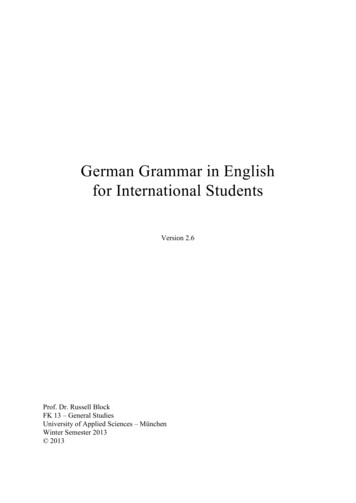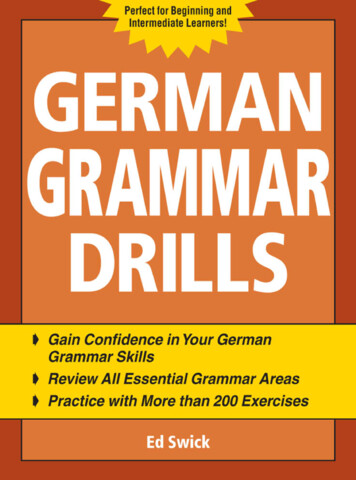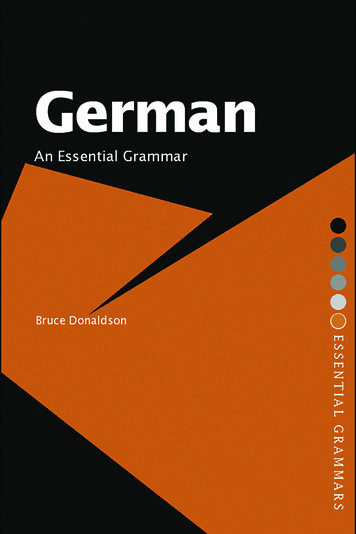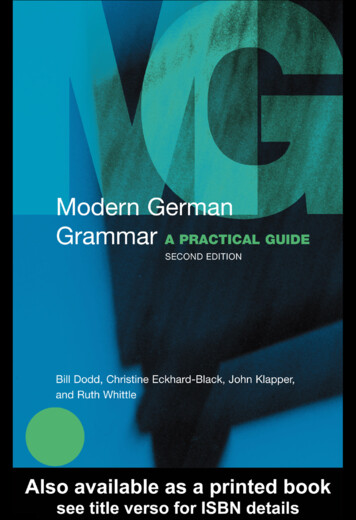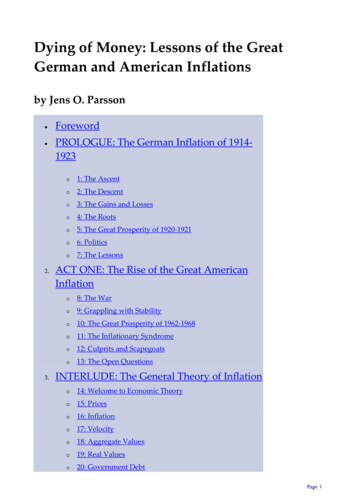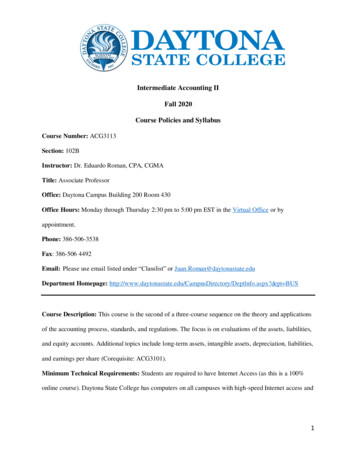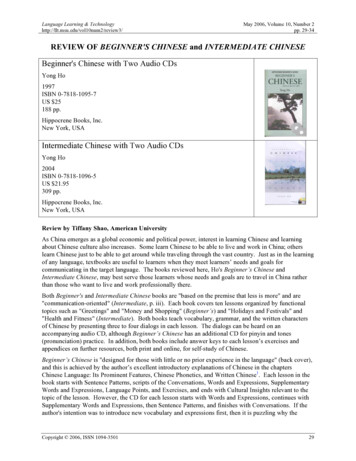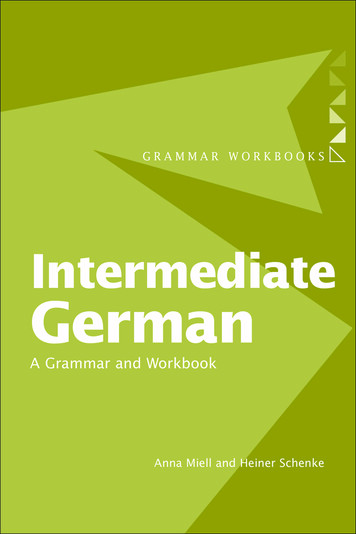
Transcription
6789401112341111INTERMEDIATE GERMAN:A GRAMMAR AND WORKBOOKIntermediate German is designed for learners who have achieved basicproficiency and wish to progress to more complex language. Its 24 unitspresent a broad range of grammatical topics, illustrated by examples whichserve as models for varied exercises that follow. These exercises enablethe student to master the relevant grammar points.Features include: authentic German, from a range of media, used throughout the book toreflect German culture, life and society illustrations of grammar points in English as well as German checklists at the end of each unit for consolidation cross-referencing to other grammar units in the book glossary of grammatical terminology full answer key to all exercisesSuitable for independent learners and students on taught courses,Intermediate German, together with its sister volume, Basic German, formsa structured course in the essentials of German.Anna Miell is University Lecturer in German at the University of Westminsterand at Trinity College of Music in Greenwich and works as a languageconsultant in London. Heiner Schenke is Senior Lecturer of German at theUniversity of Westminster and has published a number of language books.
789401112341111Other titles available in the Grammar Workbook series are:Basic CantoneseIntermediate CantoneseBasic GermanBasic ItalianBasic PolishIntermediate PolishBasic RussianIntermediate RussianBasic SpanishBasic WelshIntermediate WelshTitles of related interest published by Routledge:Colloquial Germanby Dietlinde Hatherall and Glyn HatherallModern German Grammar: A Practical Guide, Second Editionby William Dodd, Christine Eckhard-Black, John Klapperand Ruth WhittleModern German Grammar Workbook, Second Editionby William Dodd, Christine Eckhard-Black, John Klapperand Ruth Whittle
6789401112341111INTERMEDIATE GERMAN:A GRAMMAR ANDWORKBOOKAnna Miell and Heiner Schenke
789401112341111First published 2006by Routledge2 Park Square, Milton Park, Abingdon, Oxon OX14 4RNSimultaneously published in the USA and Canadaby Routledge270 Madison Ave, New York, NY 10016Routledge is an imprint of the Taylor & Francis Group, an informa business 2006 Anna Miell and Heiner SchenkeThis edition published in the Taylor & Francis e-Library, 2006.“To purchase your own copy of this or any of Taylor & Francis or Routledge’scollection of thousands of eBooks please go to www.eBookstore.tandf.co.uk.”All rights reserved. No part of this book may be reprintedor reproduced or utilised in any form or by any electronic,mechanical, or other means, now known or hereafterinvented, including photocopying and recording, or in anyinformation storage or retrieval system, without permissionin writing from the publishers.British Library Cataloguing in Publication DataA catalogue record for this book is available from theBritish LibraryLibrary of Congress Cataloging in Publication DataMiell, Anna.Intermediate German: a grammar and workbook / byAnna Miell & Heiner Schenkep. cm. – (Grammar workbook series)1. German language – Grammar. 2. German language– Textbooks for foreign speakers – English. I. Schenke,Heiner. II. Title. III. Routledge grammars. IV. Series.PF3112.M44 2006438.2′421 – dc 222006005339ISBN10: 0–415–28406–6 (hbk)ISBN10: 0–415–28407–4 (pbk)ISBN10: 0–203–32557–5 (ebk)ISBN13: 978–0–415–28406–6 (hbk)ISBN13: 978–0–415–28407–3 (pbk)ISBN13: 978–0-203–32557–5 (ebk)
6789401112341111CONTENTSPrefaceviiUnit 1Nouns and gender1Unit 2Plural of nouns9Unit 3Articles and other determiners15Unit 4Cases23Unit 5Pronouns34Unit 6Reflexive verbs42Unit 7Modal verbs50Unit 8Verbs with separable and inseparable prefixes59Unit 9Verbs and prepositions67Unit 10The present tense75Unit 11The present perfect tense81Unit 12The simple past tense89Unit 13The past perfect tense96Unit 14The future tense102Unit 15Adjectives and adverbs107Unit 16Prepositions116Unit 17Forming questions126Unit 18Conjunctions and clauses133Unit 19Word order and sentence structure141
56789401112341111ContentsUnit 20Relative clauses150Unit 21Negative constructions157Unit 22The passive voice164Unit 23Subjunctive forms172Unit 24Indirect speech180Key to exercises and checklists186Glossary of grammatical terms210Common irregular verbs215Index218
6789401112341111PREFACEIntermediate German is aimed at learners of German who have acquiredthe basics of the language and want to progress further. It is also idealfor intermediate to advanced learners who want to consolidate and extendtheir knowledge of German grammar. The book can be used on its ownor in connection with any major German coursebook and is suitable forself-study, class-based learning or reference purposes.Presentation of grammarThe book explains the essentials of German grammar in clear and simplelanguage. The format is easily accessible and grammar topics follow aprogression, which move from simple aspects to more complex features.For more in-depth study, there are cross-references to related grammaritems. Explanations are simple and avoid specialised terminology whenever possible while introducing key terms. The vocabulary is practical andfunctional.Structure of unitsThere are 24 units. Each unit covers one key grammar topic, which iscontrasted with English structures where appropriate. Most topic startsout with an overview. This is usually followed by detailed explanation inan easy to follow step-by-step layout, breaking down complex aspects intosimple segments. Examples in English and German illustrate each pointand introduce relevant vocabulary.Checklists and exercisesIntegrated exercises allow immediate transfer and practice to consolidateeach grammar point. Exercises are varied and progress from simple recognition to more complex application of grammar points.
3456789401112341111PrefaceA checklist at the end of each unit reinforces main points and providesan opportunity to self-assess understanding of the material covered.Answers to all exercises and the checklists are available in a key at theend of the book.Using the book as a grammar referenceUnit headings indicate which grammar point is covered and the index atthe end of the book refers users to the relevant units. The glossary providesclear definitions and simple explanations of key grammatical terms. Whenappropriate, cross-references are provided within units.Extra featuresExtra tips on how to make language learning easier and more successfulare provided wherever appropriate. The book also gives the learner upto-date information on the contemporary usage of grammatical structuresin German.The book is suitable for: lower intermediate to advanced students AS/A-level revision courses at university and in further education adult education courses independent learners.
678940111232241111UNIT ONENouns and genderWhat are nouns?Nouns are words used to name living creatures, objects, abstract qualitiesor rtdevelopmentGerman nouns – three gendersIn German, all nouns are classed as having one of three genders: masculine, feminine or neuter and are written with an initial capital letter. Indictionaries, the gender is usually indicated with m for masculine nouns,f for feminine nouns and nt for neuter nouns.Working out the genderOften there seems to be no obvious relationship between a noun and itsgender in German: Rock ‘skirt’ for instance is masculine, Hose ‘trousers’is feminine and Kleid ‘dress’ is neuter.However, there are two main ways that can help you to work out thegender: certain endings indicate the gender some groups of nouns, usually linked by meaning, tend to be masculine or feminine or neuter.
6789401112341111Unit 1: Nouns and genderEndings indicating the genderMasculine endingsThe following endings usually indicate that the noun is masculine:-ant-ast-ich-ig-ling-or-usder Konsonantder Palastder Teppichder Honigder Lieblingder Motorder nematerialismAn exception is das Labor ‘laboratory’.Feminine endingsThe following endings tend to belong to feminine t-ung-urdie Pizzadie Toleranzdie Wäschereidie Intelligenzdie Mehrheitdie Astrologiedie Musikdie Kommunikationdie Müdigkeitdie Kreativitätdie Erbschaftdie Bedeutungdie ancemeaning, importancehairstyleSome exceptions are: das Sofa ‘sofa’, das Genie ‘genius’, das Abitur‘A levels’.Note that about 90 per cent of nouns ending in -e are also feminine:die Anzeigedie Frageadvertquestiondie Karrieredie SchokoladecareerchocolateExceptions include: das Auge ‘eye’, das Interesse ‘interest’, der Käse‘cheese’, der Name ‘name’, and all male persons and animals endings in-e: der Junge ‘boy’, der Löwe ‘lion’ etc.
Unit 1: Nouns and 11234567894011123411113Neuter endingsThe following endings signal that a noun is neuter:-chen-il-lein-ma-ment-o-umdas Märchendas Ventildas Männleindas Dramadas Instrumentdas Autodas Zentrumfairy talevalvelittle mandramainstrumentcarcentreSome exceptions are: die Firma ‘company’, der Reichtum ‘wealth’.Groups of nounsThere are also certain groups of nouns, usually linked by meaning, whichtend to be masculine or feminine or neuter:MasculineFeminineNeuterMale persons and maleanimals:Female persons and female Young persons and younganimals:animals:der Journalist, der Tigerdie Journalistin, die Katze das Kind, das KükenDays, months and seasons: Motorbikes and ships:Most countries, towns:der Montag, der August,der Sommerdie BMW, die TitanicDeutschland, Berlin(usually used withoutarticle)Makes of cars:Numerals:Hotels, cafés, cinemas:der BMW, der Toyotadie Eins, die Milliondas Hilton, das CaféFloreAlcoholic drinks:Names of trees and flowers: Metals and chemicals:der Wein, der Schnapsdie Eiche, die Orchideedas Silber, das HeliumMany other drinks:Names of most nativerivers:Infinitives used as nouns:der Kaffee, der Saftdie Donau, die Elbedas Singen, das TanzenPoints of the compass:Foreign words ending inder Norden, der Westen-ing: das Meeting, dasTraining
6789401112341111Unit 1: Nouns and genderMasculineFeminineNeuterMost currencies:Diminutives:der Euro, der Dollardas Händchen(‘little hand’)das Tischlein(‘little table’)Exceptions include:das Bier, das Wasser;das Britische Pfund(Sterling)Exceptions include:das Mädchen and thefollowing rivers: der Main,der Rhein, der NeckarExceptions include:der Irak, die Schweiz,die Türkei, die Ukraine,die Niederlande (plural),die USA (plural)Compound nounsThe last noun defines the genderCompound nouns usually consist of two or more nouns. The gender isdefined by the last noun:der Computer das Spiel das Computerspielcomputer gameder Bauch der Tanz die Lehrerin die Bauchtanzlehrerinteacher of belly dancingAdding -sWhen joining noun noun together an extra -s is often inserted to linkthe components and to make the pronunciation easier. This usuallyhappens when the first noun ends in -heit, -ing, -ion, -keit, -ling, -schaft,-tät or -ung:der Liebling die Band die Lieblingsbandfavourite banddie Mehrheit der Beschluss der Mehrheitsbeschlussmajority decision
Unit 1: Nouns and 11234567894011122223222411115Nouns in useDeterminers and nounsWhen used in sentences, nouns normally appear with determiners such asder, die, das etc. Depending on the function of the noun within thesentence the determiners can change.For example, the definite articles der, die, das and die for plural nounsare used when the noun is the subject of a sentence (nominative case).These articles change to dem, der, dem, den if the noun is the indirectobject (dative case).Changes affecting nounsNote that nouns themselves normally change only (other than their pluralforms) in the following instances: in the genitive case, where masculine and neuter nouns add -(e)s and in the dative plural where -n is usually added.For more information see Units 3 and 4.However, there are two groups of nouns whose endings do change: theso-called weak nouns and adjectival nouns.Weak nounsAbout 10 per cent of masculine nouns, usually referring to male peopleor animals, add -(e)n to all forms apart from the nominative rPluralder Jungeden Junge-ndem Junge-ndes Junge-ndie Junge-ndie Junge-nden Junge-nder Junge-nDer Junge spielt mit seinem Gameboy.Siehst du den Jungen dort?Er kauft dem Jungen eine Flasche Wasser.(nom., sing.)(acc., sing.)(dat., sing.)Other examples include: Architekt ‘male architect’, Student ‘male student’,Herr ‘Mr’, ‘gentleman’, Tourist ‘male tourist’, Mensch ‘human being’,Name ‘name’.
6789401112341111Unit 1: Nouns and genderNote that Herr adds -n in the singular, and -en in the plural: Kennstdu Herrn Becker ‘Do you know Mr Becker?’ Meine Damen und Herren!‘Ladies and gentlemen!’.Adjectival nounsAdjectival nouns are derived from adjectives:krankreichverwandt ein Kranker, eine Krankeein Reicher, eine Reicheein Verwandter, eine Verwandteill, sick personrich personrelativeAdjectives used as nouns follow the pattern of adjectival endings. As anexample, here are all forms of Verwandte/r ‘relative’ with the iveSingular (masc.)Singular (fem.)Pluralein Verwandte
INTERMEDIATE GERMAN: A GRAMMAR AND WORKBOOK Intermediate German is designed for learners who have achieved basic proficiency and wish to progress to more complex language. Its 24 units present a broad range of grammatical topics, illustrated by examples which serve as models for varied exercises that follow. These exercises enable the student to master the relevant grammar File Size: 1018KBPage Count: 233
